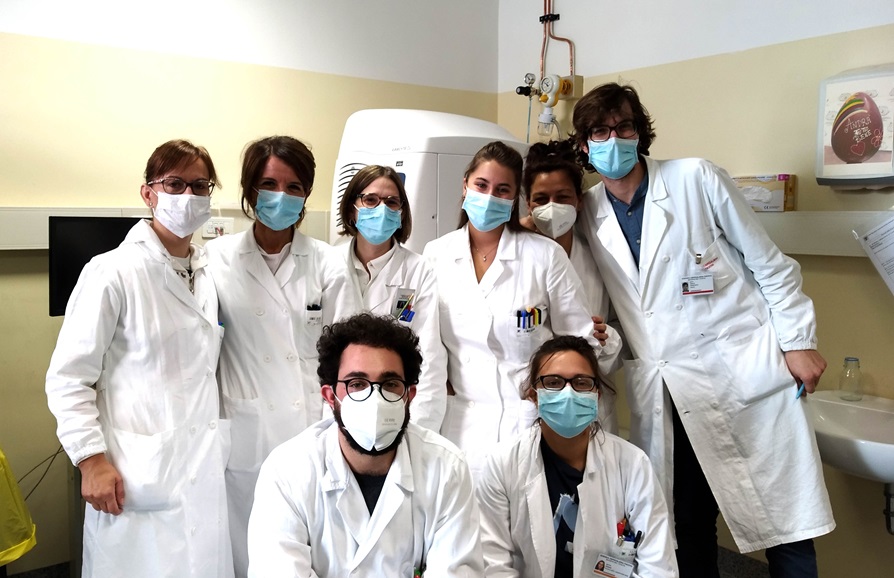Automated, high-throughput and low-cost RT-qPCR methods for SARS-CoV-2 surveillance testing using the Echo 525 Liquid Handler
 |
“Echo 525 Liquid Handler has been an essential part of our lab for SARS-CoV-2 surveillance testing. In a recent comparison, we found the tip-less and contact-free Echo 525 delivers very reliable and sensitive data for RT-qPCR reactions at 5 µL at 2.1-200 copies/µL concentration range.”
Dr. Andrea Crisanti, Professor of Microbiology at the University of Padua |
Introduction
The discovery of the coronavirus disease 2019 (COVID-19), also known as SARS-CoV-2, in Wuhan, China, has raised a global public alert [1]. This deadly and highly infectious virus has caused the world to take serious measures as the number of confirmed cases has risen continuously since the first case was reported. The Chinese government warned that international efforts are needed to overcome this outbreak. Professor Andrea Crisanti [2], University of Padua, immediately responded to this pandemic by starting a high-throughput, automated, and low-cost RT-qPCR method to test thousands of RNA samples from swabs in the Veneto area of northern Italy.
 The Echo 525 Liquid Handler, an automated, acoustic and tip-less liquid handler from Beckman Coulter Life Sciences has been an essential part of these high-throughput and cost-effective studies. Due to the high accuracy and precision of the Echo 525 down to 25 nL, the RT-qPCR assays were successfully performed at reduced volumes of 5 µL in 384-well format plates, instead of 25 µL in 96-well format plates. For the 5 µL reaction, 1 µL of extracted RNA sample from nasal swabs and 4 µL of RT-qPCR premix, including the primer and probes, were used. The reduced RT-qPCR reaction volume has been essential for using less reagent while maintaining a high limit of detection (LOD) of 2.1 copies/µL for a single sample.
The Echo 525 Liquid Handler, an automated, acoustic and tip-less liquid handler from Beckman Coulter Life Sciences has been an essential part of these high-throughput and cost-effective studies. Due to the high accuracy and precision of the Echo 525 down to 25 nL, the RT-qPCR assays were successfully performed at reduced volumes of 5 µL in 384-well format plates, instead of 25 µL in 96-well format plates. For the 5 µL reaction, 1 µL of extracted RNA sample from nasal swabs and 4 µL of RT-qPCR premix, including the primer and probes, were used. The reduced RT-qPCR reaction volume has been essential for using less reagent while maintaining a high limit of detection (LOD) of 2.1 copies/µL for a single sample.
“In our hands, the Echo has enabled reducing the turnaround and hands-on time by 92% and 75%, respectively; and has decreased the RT-qPCR reagent cost by 80%. Moreover, not using any plastic tips has been a game-changer in our lab when tips are on high-demand due to the pandemic.”
Dr. Andrea Crisanti, Professor of Microbiology at the University of Padua
Total nucleic acids were purified from 200 μL of nasopharyngeal swab samples and eluted in a final volume of 100 μL using a MagNA Pure 96 System. Detection of SARS-CoV-2 RNA was performed by an in-house, real-time RT-qPCR method, which was developed according to the protocol, primers and probes designed by Corman et al. [3] targeting the envelope (E) (E_Sarbeco_F, E_Sarbeco_R, E_Sarbeco_P1) and RNA-dependent RNA-polymerase genes of SARS-CoV-2 (RdRp: RdRp_SARSr-F, RdRp_SARSr-R, RdRP_SARSr-P1, and RdRp_SARSr-P2).
Figure 1- Workflow of the viral RNA load analysis in Prof. Crisanti’s lab
Using this method, the group has been able to study up to 5,000 samples per day with a fast turnaround time of 15 minutes vs. 3 hours for the 384-well plate reaction setup. Moreover, because the Echo is an acoustic and tip-less technology, it reduces usage of disposable tips, which is critically important because of the high demand for tips during the SARS-CoV-2 pandemic.
Comparison tests between the Echo 525 liquid handler and an automated tip-based liquid handler
Seven low-concentration RNA samples from nasal swab extracts were tested, in replicates of 10, on the Echo 525 and a tip-based liquid handler.
| Sample ID | Ct (Tip-based liquid handler, 25 μL, 7900HT Fast Real-Time PCR System) | Average Ct for 10 replicates (Echo 525, 5 μ L, QuantStudio™ 5 Real-Time PCR System |
Standard Deviation for 10 replicates on Echo 525 |
| 1 | 35 | 37 | 0.3 |
| 2 | 36 | 37 | 0.4 |
| 3 | 37 | 37 | 0.3 |
| 4 | 35 | 36 | 1.0 |
| 5 | 39 | 35 | 1.0 |
| 6 | 35 | 36 | 1.1 |
| 7 | 31 | 32 | 0.4 |
Table 1- Comparison of Ct values between RT-qPCR reactions set up using two different methods at 25 and 5 µL.
The same type of comparison between the two liquid handlers has been extended to four plates of 96-well samples on a tip-based liquid handler (25 µL) vs. 384-well samples (5 µL) on an Echo 525. Four positive control samples (RNA from human Ribonuclease P) and 25 blank samples, as negative controls, were also included. The data from comparison of the Ct values showed:
- 327 samples with no viral RNA load on both systems
- 15 samples with similar viral RNA load on both systems, with Ct ranging from 17 to 35
- 13 samples exhibiting viral load only when analyzed with the Echo 525 instrument in 384-well format and on a QuantStudio 5 thermocycler; of these 13 samples:
- Eight samples were confirmed to have viral load using other methods.
- Five samples were not monitored.
The comparison of the two data sets shows that setting up the RT-qPCR reactions in 5 µL, using the Echo 525 in a 384-well format, does not cause any loss in identifying samples with viral load.
Comparison of Limit of Detection (LOD) between 5 μL and 25 μL reactions
The LOD comparison between the 25 and 5 µL reactions showed:
- 0.82 copies/µL for a 25 µL reaction in a 96-well PCR plate and 7900HT Fast Real-Time thermocycler, with 5 µL of extracted RNA sample input.
- 2.1 copies/µL for a 5 µL reaction in a 384-well PCR plate and QuantStudio 5 thermocycler, with 1 µL of extracted RNA sample input.
The LOD was evaluated by testing 32 replicates of 10 different concentrations of RNA samples with more than 95% positivity.
Assay sensitivity was improved when using the Echo 525 to set up the 5 µL reaction in a 384-well PCR plate and QuantStudio 5, vs. using a tip-based liquid handler to set up a 25 µL reaction in a 96-well PCR plate and on a 7900HT Fast Real-Time PCR System. This can likely be attributed to the combination of using a different thermocycler and better heat transfer at smaller volumes.
Figure 2- Amplification curves for samples from a 384-well plate at 5 µL, with 2 positive controls (highlighted by green) and 1 positive sample (highlighted by yellow), and either the negative samples or negative controls (blue baseline curves).
Summary
Enhanced surveillance testing and the early detection of SARS-CoV-2 transmission in places that have not yet been affected by the virus are key to controlling its spread and reducing the substantial public health, economic and societal burdens posed by COVID-19 worldwide.
Tools such as the Echo 525 Liquid Handler enable fast, high-throughput and cost-effective applications, such as these population studies, by making them less labor-intensive and reducing reagent volumes and therefore cost. Moreover, the tip-less technology of the Echo enables more sustainable testing programs and lowers costs even more by reducing the number of disposable tips used per workflow. Reducing reaction volumes and increasing the speed of reaction setup using the Echo liquid handler can also enable scale up in testing from ~1,300 samples/day to up to ~ 5,000 samples/day.
Highlights
In Professor Crisanti’s laboratory, the standard method used prior to having an Echo 525 Liquid Handler consisted of using a tip-based liquid handler and a 96-well plate on a 7900HT Fast Real-Time PCR System. The Echo 525 Liquid Handler was added to the lab to better streamline setup of the RT-qPCR reactions post extraction using a 384-well plate on a QuantStudio 5 Real-Time PCR.
Advantages of the Echo-enabled workflow in the lab include:
- Reduced hands-on-time: 75% faster on the Echo (from 8 hours down to 2 hours)
- Decreased reagent cost: 80% savings (25 µL RT-qPCR down to 5 µL)
- Faster turnaround time: 92% faster time for reagent dispense for RT-qPCR (from 3 hours to 15 minutes)
- Decrease in plastic tip consumption: Adding to sustainability and avoiding tip supply chain issues
- Low maintenance: No requirement for users to perform liquid calibration or time-consuming maintenance
- Easy to use: The Echo platform and software are easy to use and operate.
- Fewer thermocyclers needed: By moving from 96- to 384-well plates, fewer thermocyclers were needed, which is also important due to high demand for 96-well thermocyclers during the pandemic
Acknowledgement
We would like to thank Dr. Crisanti and his team, specially Elisa Franchin and Claudia Del Vecchio for their great help with highlighting their work here with us.
Figure 3- Lab members of Dr. Crisanti's group at University of Padua in Italy
References
- World Health Organization. Novel Coronavirus (COVID-19) Situation. https://covid19.who.int (2020)
- Crisanti. A. et al. Suppression of COVID-19 outbreak in the municipality of Vò, Italy. https://www.medrxiv.org/content/10.1101/2020.04.17.20053157v1
- Corman. V.M. et al. Detection of 2019 novel coronavirus (2019-nCoV) by real-time RT-PCR. Eurosurveillance Vol. 25 doi: 10.2807/1560-7917.ES.2020.25.3.2000045 (2020)
© 2020 Beckman Coulter, Inc. All rights reserved. Beckman Coulter, the stylized logo, and the Beckman Coulter product and service marks mentioned herein are trademarks or registered trademarks of Beckman Coulter, Inc. in the United States and other countries. Echo is a trademark or registered trademark of Labcyte Inc. in the United States and other countries. All other product names and brands are properties of their respective owners.
Biomek i-Series and Echo products are for research use only and not intended or validated for use in the diagnosis of disease or other conditions.
AAG-803110.20




